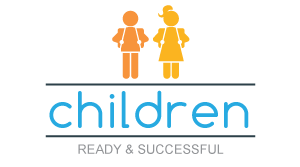 The State of Children and Families report is published annually, to advocate for young children and their families. The report provides demographic and programmatic data to illustrate key components of our local early learning systems and to highlight priority actions that NWEL is taking.
The State of Children and Families report is published annually, to advocate for young children and their families. The report provides demographic and programmatic data to illustrate key components of our local early learning systems and to highlight priority actions that NWEL is taking.
You can view the source index and glossary for each section of the report by clicking on the links below. If you would like a copy of the State of Children and Families report, you may contact Anita Garcia.
Index and Glossary
- Ready & Successful Children
- Ready & Successful Families
- Ready & Successful Professionals
- Ready & Successful Schools
| Data Indicator | Island | San Juan | Skagit | Snohomish | Whatcom | State |
|---|---|---|---|---|---|---|
| Children under 6 living in extreme poverty 1 | 6.6% | 13.1% | 8.6% | 7.2% | 9.9% | 8.8% |
| Children served by Children’s Administration 2 | 7.2% | 4.6% | 9.8% | 6.6% | 9.9% | 47.7% |
| Children with special needs, birth to 3, served by Individual Family Service Plans (ESIT) 3 | 283 | 10 | 163 | 1,399 | 362 | 13,686 |
| Children in Foster Care 4 | 70 | >10 | 140 | 658 | 322 | 8,942 |
| Kindergarteners meeting or exceeding standards in fall 2014 | ||||||
| Social-Emotional standards 5 | 81% | 93% | 71% | 78% | 79% | 74% |
| Physical standards 6 | 74% | 98% | 85% | 84% | 85% | 78% |
| Literacy standards 7 | 91% | 98% | 75% | 83% | 89% | 79% |
| Language standards 8 | 78% | 95% | 72% | 73% | 82% | 70% |
| Cognitive standareds 9 | 79% | 100% | 78% | 76% | 84% | 74% |
| Math standards 10 | 53% | 86% | 50% | 59% | 65% | 53% |
| 8th gradeers with depressive symptoms 11 | 29% | 24% | 30% | 28% | 28% | 26% |
| On-time graduation rate, public schools 12 | 82% | 83% | 71% | 78% | 75% | 77% |
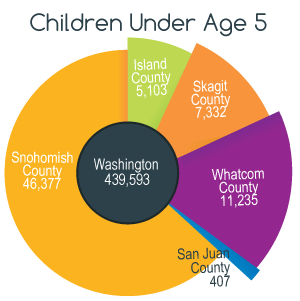 |
Source: 2014 The data used for this measure come from the Washington State Office of Financial Management (OFM), Estimates of April 1 Population, Small Area Demographic Estimates (SADE). Data were provided by OFM on May 6, 2015. Data can also be found here. |
| Source: Washington State Health Care Authority 2013 | 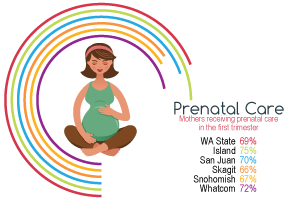 |
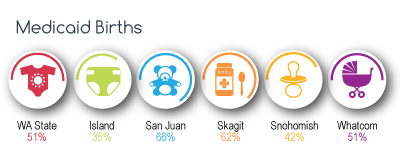 |
Source: 2013 State of Washington – First Steps Database: Prenatal & Postpartum Maternity Support Services Use by Women with 2012 Medicaid-Paid Births |
| Source: Early Services for Infants and Toddlers, Washington State Department of Early Learning, July 1, 2014-June 30, 2015 | 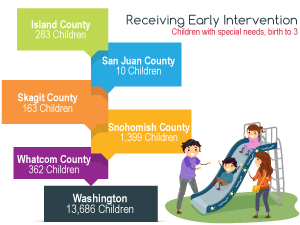 |
1 Source: Annie E Casey Kids Count Data Center: The U.S. Census Bureau’s American Fact Finder, 2009-2013 American Community Survey (ACS) 5-Year Estimates. Note: The number and share of children under age 6 who live in families with incomes less than 50 percent of the federal poverty level, as defined by the U.S. Office of Management and Budget. The federal poverty definition consists of a series of thresholds based on family size and composition. In 2013, 50% of the poverty threshold for a family of two adults and two children was $11,812.
2 Source: Annie E Casey Kids Count Data Center: 2012 Data for this measure come from the Washington State Department of Social and Health Services (DSHS), Research and Data Analysis (RDA), Client Services Database which compiles client service and expenditures records from more than 20 of the agency’s client record and payment systems. The figures reported here are also referred to as “User rates” in their annual report. Note: Percent of children under 18 years of age served by Children’s Administration. Children’s Administration services are provided to children and their families and include Adoption and Adoption Support, Child Protective Services (CPS), Child and Family Welfare Services, Family Reconciliation Services (FRS), and Family Voluntary Services.
3 Source: Early Services for Infants and Toddlers, Washington State Department of Early Learning, July 1, 2014-June 30, 2015. Note: Early Support for Infants & Toddlers: Department of Early Learning provides services to children birth to three who have disabilities and/or developmental delays. Eligible infants and toddlers and their families are entitled to individualized, quality early intervention services in accordance with the federal Individuals with Disabilities Education Act (IDEA), Part C. An Individual Family Service Plan (IFSP) is developed with family input. Early intervention services during the first years can make a big difference in a child’s life.
4 Source: Annie E Casey Kids Count Data Center: 2013 Data for this measure come from the Washington State Department of Social and Health Services (DSHS), Research and Data Analysis (RDA), Client Services Database which compiles client service and expenditures records from more than 20 of the agency’s client record and payment systems. The figures reported here are also referred to as “User rates” in their annual report. Note: According to DSHS, “Foster Care Placement Services are provided when children need short-term or temporary protection because they are abused, neglected, and/or involved in family conflict. The goal of Foster Care Placement Services is to return children to their homes or to find another permanent home as early as possible. Children are served in out-of-home placements exclusively. Placement types include traditional Foster Care Placements as well as placements in Family Receiving Homes. Client counts for Foster Care Placement Services include only the children being served, not their families. Children receiving Foster Care Placement Services are served exclusively in out-of-home settings. Foster Care Placement Services may be provided without prior Child Protective Services (CPS) involvement.”
5 Source: OSPI, Fall 2014. Note: The Washington Kindergarten Inventory of Developing Skills (WaKIDS) is a process that helps to ensure a successful start to the K-12 experience. WaKIDS has three components: Family Connection welcomes families into the K-12 system as partners in their child’s education, Whole-Child Assessment gives kindergarten teachers information about the social and emotional, physical, cognitive and linguistic development of the children in their classrooms and Early Learning Collaboration, which aligns practices of early learning professionals and kindergarten teachers to support smooth transitions for children. Data Source: Numbers of WaKIDS participant districts are based on preliminary information from the Washington State Office of Superintendent of Public Instruction (OSPI) and includes those that voluntarily adopted into the program early (before they are required by the state).
6 Source: OSPI, Fall 2014. Note: The Washington Kindergarten Inventory of Developing Skills (WaKIDS) is a process that helps to ensure a successful start to the K-12 experience. WaKIDS has three components: Family Connection welcomes families into the K-12 system as partners in their child’s education, Whole-Child Assessment gives kindergarten teachers information about the social and emotional, physical, cognitive and linguistic development of the children in their classrooms and Early Learning Collaboration, which aligns practices of early learning professionals and kindergarten teachers to support smooth transitions for children. Data Source: Numbers of WaKIDS participant districts are based on preliminary information from the Washington State Office of Superintendent of Public Instruction (OSPI) and includes those that voluntarily adopted into the program early (before they are required by the state).
7 Source: OSPI, Fall 2014. Note: The Washington Kindergarten Inventory of Developing Skills (WaKIDS) is a process that helps to ensure a successful start to the K-12 experience. WaKIDS has three components: Family Connection welcomes families into the K-12 system as partners in their child’s education, Whole-Child Assessment gives kindergarten teachers information about the social and emotional, physical, cognitive and linguistic development of the children in their classrooms and Early Learning Collaboration, which aligns practices of early learning professionals and kindergarten teachers to support smooth transitions for children. Data Source: Numbers of WaKIDS participant districts are based on preliminary information from the Washington State Office of Superintendent of Public Instruction (OSPI) and includes those that voluntarily adopted into the program early (before they are required by the state).
8 Source: OSPI, Fall 2014. Note: The Washington Kindergarten Inventory of Developing Skills (WaKIDS) is a process that helps to ensure a successful start to the K-12 experience. WaKIDS has three components: Family Connection welcomes families into the K-12 system as partners in their child’s education, Whole-Child Assessment gives kindergarten teachers information about the social and emotional, physical, cognitive and linguistic development of the children in their classrooms and Early Learning Collaboration, which aligns practices of early learning professionals and kindergarten teachers to support smooth transitions for children. Data Source: Numbers of WaKIDS participant districts are based on preliminary information from the Washington State Office of Superintendent of Public Instruction (OSPI) and includes those that voluntarily adopted into the program early (before they are required by the state).
9 Source: OSPI, Fall 2014. Note: The Washington Kindergarten Inventory of Developing Skills (WaKIDS) is a process that helps to ensure a successful start to the K-12 experience. WaKIDS has three components: Family Connection welcomes families into the K-12 system as partners in their child’s education, Whole-Child Assessment gives kindergarten teachers information about the social and emotional, physical, cognitive and linguistic development of the children in their classrooms and Early Learning Collaboration, which aligns practices of early learning professionals and kindergarten teachers to support smooth transitions for children. Data Source: Numbers of WaKIDS participant districts are based on preliminary information from the Washington State Office of Superintendent of Public Instruction (OSPI) and includes those that voluntarily adopted into the program early (before they are required by the state).
10 Source: OSPI, Fall 2014. Note: The Washington Kindergarten Inventory of Developing Skills (WaKIDS) is a process that helps to ensure a successful start to the K-12 experience. WaKIDS has three components: Family Connection welcomes families into the K-12 system as partners in their child’s education, Whole-Child Assessment gives kindergarten teachers information about the social and emotional, physical, cognitive and linguistic development of the children in their classrooms and Early Learning Collaboration, which aligns practices of early learning professionals and kindergarten teachers to support smooth transitions for children. Data Source: Numbers of WaKIDS participant districts are based on preliminary information from the Washington State Office of Superintendent of Public Instruction (OSPI) and includes those that voluntarily adopted into the program early (before they are required by the state).
11 Source: 2014 Washington HYS results generated at AskHYS.net Note: Depressive Symptoms: Feeling sad, hopeless or helpless to such an extent it effects your daily activities every day for two or more weeks at some point in the past year.
12 Source: Annie E Casey Kids Count Data Center: 2013-2014 data for this measure come from the Washington State Office of Superintendent of Public Instruction (OSPI). Data were retrieved on April 23, 2015 from “Graduation and Drop out Statistics” reports, and Appendices A and B at this link. Note: A student graduates on-time if he/she receives a high school diploma within four years of starting 9th grade. Total graduation rate is the percentage of all students who graduated from high school within four years after they started 9th grade. The numerator is all high school students who graduated with a high school diploma within four years of starting 9th grade. The denominator is the total cohort size who started 9th grade four years prior to graduation.

